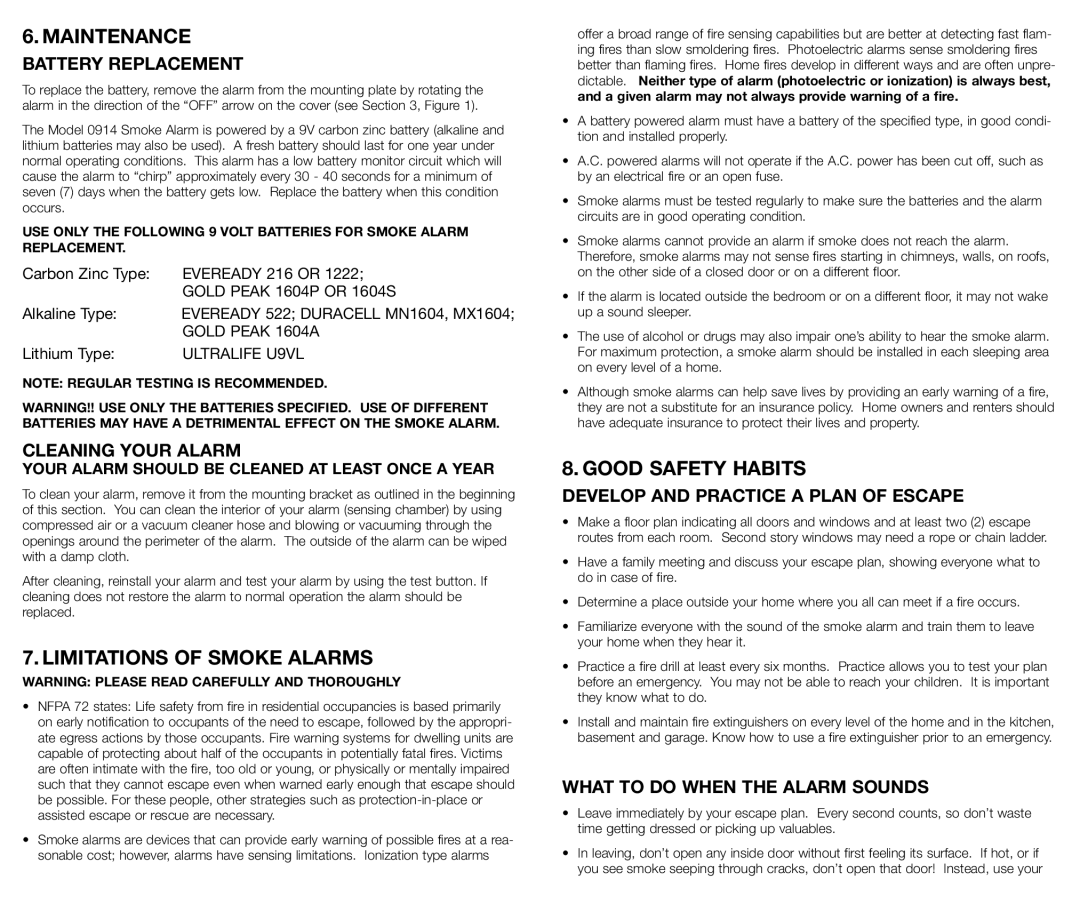6. MAINTENANCE
BATTERY REPLACEMENT
To replace the battery, remove the alarm from the mounting plate by rotating the alarm in the direction of the “OFF” arrow on the cover (see Section 3, Figure 1).
The Model 0914 Smoke Alarm is powered by a 9V carbon zinc battery (alkaline and lithium batteries may also be used). A fresh battery should last for one year under normal operating conditions. This alarm has a low battery monitor circuit which will cause the alarm to “chirp” approximately every 30 - 40 seconds for a minimum of seven (7) days when the battery gets low. Replace the battery when this condition occurs.
USE ONLY THE FOLLOWING 9 VOLT BATTERIES FOR SMOKE ALARM REPLACEMENT.
Carbon Zinc Type: | EVEREADY 216 OR 1222; |
| GOLD PEAK 1604P OR 1604S |
Alkaline Type: | EVEREADY 522; DURACELL MN1604, MX1604; |
| GOLD PEAK 1604A |
Lithium Type: | ULTRALIFE U9VL |
NOTE: REGULAR TESTING IS RECOMMENDED.
WARNING!! USE ONLY THE BATTERIES SPECIFIED. USE OF DIFFERENT BATTERIES MAY HAVE A DETRIMENTAL EFFECT ON THE SMOKE ALARM.
CLEANING YOUR ALARM
YOUR ALARM SHOULD BE CLEANED AT LEAST ONCE A YEAR
To clean your alarm, remove it from the mounting bracket as outlined in the beginning of this section. You can clean the interior of your alarm (sensing chamber) by using compressed air or a vacuum cleaner hose and blowing or vacuuming through the openings around the perimeter of the alarm. The outside of the alarm can be wiped with a damp cloth.
After cleaning, reinstall your alarm and test your alarm by using the test button. If cleaning does not restore the alarm to normal operation the alarm should be replaced.
7. LIMITATIONS OF SMOKE ALARMS
WARNING: PLEASE READ CAREFULLY AND THOROUGHLY
•NFPA 72 states: Life safety from fire in residential occupancies is based primarily on early notification to occupants of the need to escape, followed by the appropri- ate egress actions by those occupants. Fire warning systems for dwelling units are capable of protecting about half of the occupants in potentially fatal fires. Victims are often intimate with the fire, too old or young, or physically or mentally impaired such that they cannot escape even when warned early enough that escape should be possible. For these people, other strategies such as protection-in-place or assisted escape or rescue are necessary.
•Smoke alarms are devices that can provide early warning of possible fires at a rea- sonable cost; however, alarms have sensing limitations. Ionization type alarms
offer a broad range of fire sensing capabilities but are better at detecting fast flam- ing fires than slow smoldering fires. Photoelectric alarms sense smoldering fires better than flaming fires. Home fires develop in different ways and are often unpre- dictable. Neither type of alarm (photoelectric or ionization) is always best, and a given alarm may not always provide warning of a fire.
•A battery powered alarm must have a battery of the specified type, in good condi- tion and installed properly.
•A.C. powered alarms will not operate if the A.C. power has been cut off, such as by an electrical fire or an open fuse.
•Smoke alarms must be tested regularly to make sure the batteries and the alarm circuits are in good operating condition.
•Smoke alarms cannot provide an alarm if smoke does not reach the alarm. Therefore, smoke alarms may not sense fires starting in chimneys, walls, on roofs, on the other side of a closed door or on a different floor.
•If the alarm is located outside the bedroom or on a different floor, it may not wake up a sound sleeper.
•The use of alcohol or drugs may also impair one’s ability to hear the smoke alarm. For maximum protection, a smoke alarm should be installed in each sleeping area on every level of a home.
•Although smoke alarms can help save lives by providing an early warning of a fire, they are not a substitute for an insurance policy. Home owners and renters should have adequate insurance to protect their lives and property.
8. GOOD SAFETY HABITS
DEVELOP AND PRACTICE A PLAN OF ESCAPE
•Make a floor plan indicating all doors and windows and at least two (2) escape routes from each room. Second story windows may need a rope or chain ladder.
•Have a family meeting and discuss your escape plan, showing everyone what to do in case of fire.
•Determine a place outside your home where you all can meet if a fire occurs.
•Familiarize everyone with the sound of the smoke alarm and train them to leave your home when they hear it.
•Practice a fire drill at least every six months. Practice allows you to test your plan before an emergency. You may not be able to reach your children. It is important they know what to do.
•Install and maintain fire extinguishers on every level of the home and in the kitchen, basement and garage. Know how to use a fire extinguisher prior to an emergency.
WHAT TO DO WHEN THE ALARM SOUNDS
•Leave immediately by your escape plan. Every second counts, so don’t waste time getting dressed or picking up valuables.
•In leaving, don’t open any inside door without first feeling its surface. If hot, or if you see smoke seeping through cracks, don’t open that door! Instead, use your
